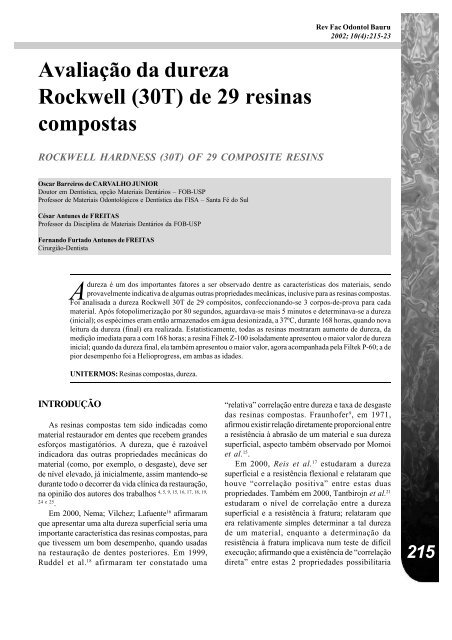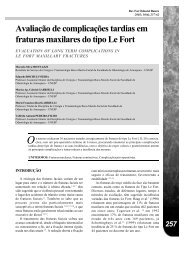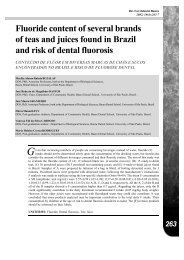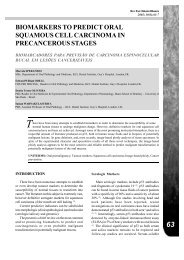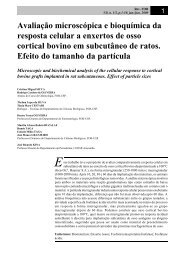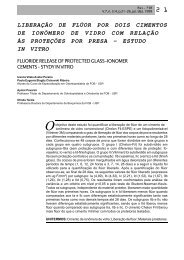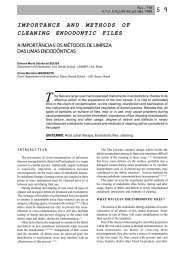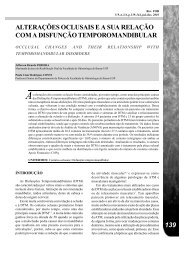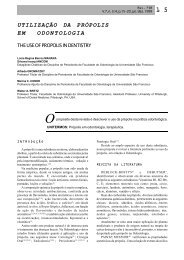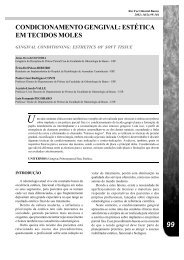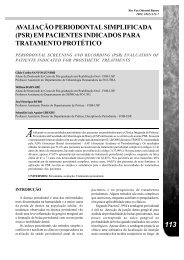Avaliação da dureza Rockwell (30T) de 29 resinas compostas
Avaliação da dureza Rockwell (30T) de 29 resinas compostas
Avaliação da dureza Rockwell (30T) de 29 resinas compostas
Create successful ePaper yourself
Turn your PDF publications into a flip-book with our unique Google optimized e-Paper software.
<strong>Avaliação</strong> <strong>da</strong> <strong>dureza</strong><br />
<strong>Rockwell</strong> (<strong>30T</strong>) <strong>de</strong> <strong>29</strong> <strong>resinas</strong><br />
<strong>compostas</strong><br />
ROCKWELL HARDNESS (<strong>30T</strong>) OF <strong>29</strong> COMPOSITE RESINS<br />
Oscar Barreiros <strong>de</strong> CARVALHO JUNIOR<br />
Doutor em Dentística, opção Materiais Dentários – FOB-USP<br />
Professor <strong>de</strong> Materiais Odontológicos e Dentística <strong>da</strong>s FISA – Santa Fé do Sul<br />
César Antunes <strong>de</strong> FREITAS<br />
Professor <strong>da</strong> Disciplina <strong>de</strong> Materiais Dentários <strong>da</strong> FOB-USP<br />
Fernando Furtado Antunes <strong>de</strong> FREITAS<br />
Cirurgião-Dentista<br />
INTRODUÇÃO<br />
As <strong>resinas</strong> <strong>compostas</strong> tem sido indica<strong>da</strong>s como<br />
material restaurador em <strong>de</strong>ntes que recebem gran<strong>de</strong>s<br />
esforços mastigatórios. A <strong>dureza</strong>, que é razoável<br />
indicadora <strong>da</strong>s outras proprie<strong>da</strong><strong>de</strong>s mecânicas do<br />
material (como, por exemplo, o <strong>de</strong>sgaste), <strong>de</strong>ve ser<br />
<strong>de</strong> nível elevado, já inicialmente, assim mantendo-se<br />
durante todo o <strong>de</strong>correr <strong>da</strong> vi<strong>da</strong> clínica <strong>da</strong> restauração,<br />
na opinião dos autores dos trabalhos<br />
4, 5, 9, 15, 16, 17, 18, 19,<br />
24 e 25 .<br />
Em 2000, Nema; Vilchez; Lafuente 16 afirmaram<br />
que apresentar uma alta <strong>dureza</strong> superficial seria uma<br />
importante característica <strong>da</strong>s <strong>resinas</strong> <strong>compostas</strong>, para<br />
que tivessem um bom <strong>de</strong>sempenho, quando usa<strong>da</strong>s<br />
na restauração <strong>de</strong> <strong>de</strong>ntes posteriores. Em 1999,<br />
Rud<strong>de</strong>l et al. 18 afirmaram ter constatado uma<br />
Rev Fac Odontol Bauru<br />
2002; 10(4):215-23<br />
A<strong>dureza</strong> é um dos importantes fatores a ser observado <strong>de</strong>ntre as características dos materiais, sendo<br />
provavelmente indicativa <strong>de</strong> algumas outras proprie<strong>da</strong><strong>de</strong>s mecânicas, inclusive para as <strong>resinas</strong> <strong>compostas</strong>.<br />
Foi analisa<strong>da</strong> a <strong>dureza</strong> <strong>Rockwell</strong> <strong>30T</strong> <strong>de</strong> <strong>29</strong> compósitos, confeccionando-se 3 corpos-<strong>de</strong>-prova para ca<strong>da</strong><br />
material. Após fotopolimerização por 80 segundos, aguar<strong>da</strong>va-se mais 5 minutos e <strong>de</strong>terminava-se a <strong>dureza</strong><br />
(inicial); os espécimes eram então armazenados em água <strong>de</strong>sioniza<strong>da</strong>, a 37ºC, durante 168 horas, quando nova<br />
leitura <strong>da</strong> <strong>dureza</strong> (final) era realiza<strong>da</strong>. Estatisticamente, to<strong>da</strong>s as <strong>resinas</strong> mostraram aumento <strong>de</strong> <strong>dureza</strong>, <strong>da</strong><br />
medição imediata para a com 168 horas; a resina Filtek Z-100 isola<strong>da</strong>mente apresentou o maior valor <strong>de</strong> <strong>dureza</strong><br />
inicial; quando <strong>da</strong> <strong>dureza</strong> final, ela também apresentou o maior valor, agora acompanha<strong>da</strong> pela Filtek P-60; a <strong>de</strong><br />
pior <strong>de</strong>sempenho foi a Helioprogress, em ambas as i<strong>da</strong><strong>de</strong>s.<br />
UNITERMOS: Resinas <strong>compostas</strong>, <strong>dureza</strong>.<br />
“relativa” correlação entre <strong>dureza</strong> e taxa <strong>de</strong> <strong>de</strong>sgaste<br />
<strong>da</strong>s <strong>resinas</strong> <strong>compostas</strong>. Fraunhofer 9 , em 1971,<br />
afirmou existir relação diretamente proporcional entre<br />
a resistência à abrasão <strong>de</strong> um material e sua <strong>dureza</strong><br />
superficial, aspecto também observado por Momoi<br />
et al. 15 .<br />
Em 2000, Reis et al. 17 estu<strong>da</strong>ram a <strong>dureza</strong><br />
superficial e a resistência flexional e relataram que<br />
houve “correlação positiva” entre estas duas<br />
proprie<strong>da</strong><strong>de</strong>s. Também em 2000, Tantbirojn et al. 21<br />
estu<strong>da</strong>ram o nível <strong>de</strong> correlação entre a <strong>dureza</strong><br />
superficial e a resistência à fratura; relataram que<br />
era relativamente simples <strong>de</strong>terminar a tal <strong>dureza</strong><br />
<strong>de</strong> um material, enquanto a <strong>de</strong>terminação <strong>da</strong><br />
resistência à fratura implicava num teste <strong>de</strong> difícil<br />
execução; afirmando que a existência <strong>de</strong> “correlação<br />
direta” entre estas 2 proprie<strong>da</strong><strong>de</strong>s possibilitaria<br />
215
216<br />
Carvaho Jr. O B, Freitas C A, Freitas F F A<br />
AVALIAÇÃO DA DUREZA ROCKWEL (<strong>30T</strong>) DE <strong>29</strong> RESINAS COMPOSTAS<br />
<strong>de</strong>terminar-se apenas a <strong>dureza</strong>, facilitando<br />
posteriores estudos, relataram ter observado um<br />
coeficiente que variou <strong>de</strong> 0,90 a 0,97, o que indicava<br />
haver uma gran<strong>de</strong> “correlação positiva” entre estas<br />
duas proprie<strong>da</strong><strong>de</strong>s analisa<strong>da</strong>s.<br />
Em 1992, Willens et al. 24 , em um estudo bastante<br />
amplo, no qual observaram várias proprie<strong>da</strong><strong>de</strong>s <strong>de</strong><br />
diversas <strong>resinas</strong> <strong>compostas</strong>, afirmaram que, apesar<br />
<strong>da</strong> importância relativa do teste <strong>de</strong> <strong>dureza</strong>, ficava<br />
comprova<strong>da</strong> sua relação direta com as <strong>de</strong>mais<br />
proprie<strong>da</strong><strong>de</strong>s mecânicas por eles estu<strong>da</strong><strong>da</strong>s.<br />
Atualmente, um gran<strong>de</strong> número <strong>de</strong>stes produtos<br />
é encontrado no comércio, dificultando a sua escolha<br />
pelos cirurgiões-<strong>de</strong>ntistas. Com base nos raciocínios<br />
aqui expostos, estabeleceu-se que o objetivo <strong>da</strong><br />
presente pesquisa seria avaliar a <strong>dureza</strong> do maior<br />
número possível <strong>de</strong> <strong>resinas</strong> encontra<strong>da</strong>s no comércio<br />
nacional.<br />
MATERIAIS E MÉTODOS<br />
Foram encontra<strong>da</strong>s <strong>29</strong> <strong>resinas</strong> <strong>compostas</strong>,<br />
especifica<strong>da</strong>s a seguir na tabela 1, com algumas <strong>de</strong><br />
suas características, <strong>de</strong>scritas pelos respectivos<br />
fabricantes. Segundo a forma <strong>de</strong> <strong>de</strong>nominação dos<br />
fabricantes, as 5 “<strong>de</strong> micropartículas” estão<br />
i<strong>de</strong>ntifica<strong>da</strong>s com a sigla mp, as 17 “híbri<strong>da</strong>s<br />
tradicionais” com ht e as 7 “con<strong>de</strong>nsáveis” por cd.<br />
Como o critério <strong>de</strong> cores não é o mesmo para to<strong>da</strong>s as<br />
<strong>resinas</strong> analisa<strong>da</strong>s, procurou-se escolher, para ca<strong>da</strong><br />
uma <strong>de</strong>las, aquela cor mais freqüentemente utiliza<strong>da</strong>,<br />
o que equivaleria à escolha <strong>de</strong> uma mesma cor.<br />
Os corpos-<strong>de</strong>-prova foram confeccionados em<br />
ambiente com temperatura <strong>de</strong> 23 ± 2ºC e umi<strong>da</strong><strong>de</strong><br />
relativa do ar <strong>de</strong> 50 ± 10%. Assim, para ca<strong>da</strong> material<br />
testado, 3 espécimes foram confeccionados, levandose<br />
a resina (com instrumento metálico próprio) à<br />
cavi<strong>da</strong><strong>de</strong> do suporte metálico, a qual apresentava-se<br />
com 2 mm <strong>de</strong> profundi<strong>da</strong><strong>de</strong> por 7 mm <strong>de</strong> diâmetro, até<br />
seu preenchimento proposita<strong>da</strong>mente em ligeiro<br />
excesso; sobre a resina era então coloca<strong>da</strong> uma fita<br />
<strong>de</strong> poliéster, pressiona<strong>da</strong> com uma lâmina <strong>de</strong> vidro (para<br />
tornar sua superfície lisa e plana) e imediatamente<br />
fotopolimeriza<strong>da</strong> (ou seja, fotoativa<strong>da</strong>) parcialmente<br />
durante 20 segundos, através <strong>de</strong> um aparelho XL 1.500<br />
(<strong>da</strong> 3M do Brasil), cuja ponta ativa era manti<strong>da</strong> em<br />
contato com a cita<strong>da</strong> lâmina; então esta era removi<strong>da</strong><br />
e complementa<strong>da</strong> a fotopolimerização com mais 60<br />
segundos, com a ponta agora encosta<strong>da</strong> diretamente<br />
na fita matriz. A intensi<strong>da</strong><strong>de</strong> <strong>de</strong> luz do fotopolimerizador<br />
foi inicialmente aferi<strong>da</strong> com radiômetro próprio (mo<strong>de</strong>lo<br />
100, Demetron Research Corporation, EUA), sendo<br />
verifica<strong>da</strong> como <strong>de</strong> 450 mW/cm 2 ; a ca<strong>da</strong> 3 corpos-<strong>de</strong>prova<br />
confeccionados, era executa<strong>da</strong> nova aferição.<br />
Para ca<strong>da</strong> espécime, aguar<strong>da</strong>va-se 5 minutos<br />
(contados a partir do final <strong>da</strong> fotopolimerização) e<br />
media-se a <strong>dureza</strong> <strong>Rockwell</strong> <strong>30T</strong> (o que implica em<br />
utilizar-se um penetrador esférico <strong>de</strong> aço, com 1,588<br />
± 0,003 mm <strong>de</strong> diâmetro, polido e isento <strong>de</strong><br />
irregulari<strong>da</strong><strong>de</strong>s superficiais, com carga <strong>de</strong> 30 kgf),<br />
num aparelho Testor HT 1a (fabricado pela Sussen<br />
Wolpert, <strong>da</strong> Alemanha). Assim, 3 medições eram<br />
realiza<strong>da</strong>s, respeitando-se a distância mínima <strong>de</strong> 1<br />
mm entre as marcas e evitando-se as áreas<br />
periféricas <strong>da</strong> amostra. Neste aparelho, uma précarga<br />
<strong>de</strong> 3 kgf é aplica<strong>da</strong>, para padronizar as<br />
condições do ensaio, eliminando-se o efeito aleatório<br />
<strong>de</strong> possíveis irregulari<strong>da</strong><strong>de</strong>s. A média aritmética<br />
<strong>de</strong>stas 3 leituras era consi<strong>de</strong>ra<strong>da</strong> a <strong>dureza</strong> inicial do<br />
corpo-<strong>de</strong>-prova. Após ficar armazenado em água<br />
<strong>de</strong>sioniza<strong>da</strong>, a 37ºC, durante 168 horas, o espécime<br />
era submetido a nova leitura, seguindo-se o mesmo<br />
método citado, para <strong>de</strong>terminar-se a <strong>dureza</strong> final.<br />
RESULTADOS<br />
A Tabela 2 contém os valores <strong>de</strong> <strong>dureza</strong> (médias<br />
dos 3 corpos-<strong>de</strong>-prova e respectivos <strong>de</strong>svios-padrão)<br />
<strong>da</strong>s <strong>resinas</strong> analisa<strong>da</strong>s, nas duas i<strong>da</strong><strong>de</strong>s estu<strong>da</strong><strong>da</strong>s.<br />
Foi constatado o aumento <strong>da</strong> <strong>dureza</strong>, em função<br />
do aumento <strong>da</strong> i<strong>da</strong><strong>de</strong>, ou seja, <strong>da</strong> medição imediata<br />
(<strong>dureza</strong> inicial) para a <strong>de</strong> 168 horas (<strong>dureza</strong> final),<br />
através <strong>da</strong> análise <strong>da</strong> variância, a 2 critérios, mo<strong>de</strong>lo<br />
fixo, com medi<strong>da</strong>s repeti<strong>da</strong>s no tempo, ao nível <strong>de</strong><br />
significância <strong>de</strong> 5%. O valor do f<br />
obs<br />
foi <strong>de</strong> 213,68<br />
para as <strong>resinas</strong> e <strong>de</strong> 30988,96 para os tempos, tendo<br />
existido interação <strong>de</strong>stes fatores.<br />
Os valores <strong>de</strong> <strong>dureza</strong> inicial apresentados na<br />
Tabela 2 foram submetidos a um teste <strong>de</strong> contrastes<br />
<strong>de</strong> Tukey, ao nível <strong>de</strong> 5% <strong>de</strong> significância, cujos<br />
resultados permitiram confeccionar a Tabela 3.<br />
Os valores <strong>de</strong> <strong>dureza</strong> final apresentados na tabela<br />
2 foram também submetidos a um teste <strong>de</strong> contrastes<br />
<strong>de</strong> Tukey, ao nível <strong>de</strong> 5% <strong>de</strong> significância, cujos<br />
resultados permitiram confeccionar a Tabela 4.
TABELA 1 - Resinas analisa<strong>da</strong>s<br />
Nome do produto<br />
1. ALERT<br />
2. Amelogen Microfill<br />
3. Amelogen Universal<br />
4. Ariston pHc<br />
5. Charisma<br />
6. Definite<br />
7. Degufill Mineral<br />
8. Durafill VS<br />
9. Fill Magic<br />
10. Fill Magic Con<strong>de</strong>nsável<br />
11. Filtek P-60<br />
12. Filtek Z-100<br />
13. Filtek Z-250<br />
14. Glacier<br />
15. Helio Fill AP<br />
16. Heliomolar<br />
Tipo<br />
cd<br />
mp<br />
ht<br />
cd<br />
ht<br />
ht<br />
ht<br />
mp<br />
ht<br />
cd<br />
cd<br />
ht<br />
ht<br />
ht<br />
mp<br />
ht<br />
Fabricante<br />
Jeneric/Pentron,<br />
EUA<br />
Ultra<strong>de</strong>nt, EUA<br />
Ultra<strong>de</strong>nt, EUA<br />
Viva<strong>de</strong>nt,<br />
Liechtenstein<br />
Kulzer,<br />
Alemanha<br />
Degussa,<br />
Alemanha<br />
Degussa,<br />
Alemanha<br />
Kulzer,<br />
Alemanha<br />
Vigo<strong>de</strong>nt,<br />
Rio <strong>de</strong> Janeiro<br />
Vigo<strong>de</strong>nt,<br />
Rio <strong>de</strong> Janeiro<br />
3M, São Paulo<br />
3M, São Paulo<br />
3M, São Paulo<br />
SDI, Austrália<br />
Viva<strong>de</strong>nt,<br />
Liechtenstein<br />
Cor<br />
A 2<br />
A 3,5<br />
A 3,5<br />
U<br />
A 35<br />
A 3,5<br />
A 3,5<br />
A 35<br />
A 3,5<br />
A 3<br />
A 3<br />
A 3,5<br />
A 3,5<br />
A 3,5<br />
A 2<br />
35<br />
Rev Fac Odontol Bauru<br />
2002; 10(4):215-23<br />
Quantia (%) <strong>de</strong> carga<br />
Tipo <strong>da</strong> carga<br />
84 (peso)<br />
Sílica coloi<strong>da</strong>l + vidro <strong>de</strong> boro<br />
silicato <strong>de</strong> bário<br />
40 (volume)<br />
Sílica coloi<strong>da</strong>l<br />
60 (volume)<br />
Não consta<br />
79,2 (peso)<br />
sílica coloi<strong>da</strong>l +<br />
fluorsilicato <strong>de</strong> bário e alumínio +<br />
fluoreto <strong>de</strong> itérbio<br />
Não consta<br />
Silicato <strong>de</strong> bário e alumínio<br />
+ sílica coloi<strong>da</strong>l<br />
80 (peso).<br />
Vidro <strong>de</strong> bário + sílica coloi<strong>da</strong>l<br />
Não consta.<br />
Vidro <strong>de</strong> borosilicato <strong>de</strong> alumínio e bário<br />
+ fosfato <strong>de</strong> cálcio-fluoreto-apatita<br />
+ sílica coloi<strong>da</strong>l<br />
50,5 (peso)<br />
Sílica coloi<strong>da</strong>l<br />
77 (peso).<br />
Silicato <strong>de</strong> bário e alumínio<br />
+ sílica coloi<strong>da</strong>l<br />
81 (peso)<br />
vidro <strong>de</strong> bário + vidro <strong>de</strong> flúor<br />
+ sílica coloi<strong>da</strong>l<br />
62 (volume)<br />
vidro <strong>de</strong> zircônia sinterizado à sílica<br />
coloi<strong>da</strong>l<br />
71 (volume)<br />
vidro <strong>de</strong> zircônia sinterizado<br />
à silica coloi<strong>da</strong>l<br />
60 (volume)<br />
vidro <strong>de</strong> zircônia sinterizado<br />
à silica coloi<strong>da</strong>l<br />
62 (volume)<br />
Vidro + sílica coloi<strong>da</strong>l<br />
Não consta<br />
Sílica coloi<strong>da</strong>l<br />
66 (volume).<br />
sílica coloi<strong>da</strong>l + trifluoreto <strong>de</strong> itérbio<br />
(continua)<br />
217
218<br />
Carvalho Jr. O B, Freitas C A, Freitas F F A<br />
AVALIAÇÃO DA DUREZA ROCKWEL (<strong>30T</strong>) DE <strong>29</strong> RESINAS COMPOSTAS<br />
(continuação)<br />
TABELA 1 - Resinas analisa<strong>da</strong>s<br />
Nome do produto<br />
17. Helioprogress<br />
18. Herculite XRV<br />
19. Prodigy<br />
20. Prodigy Con<strong>de</strong>nsável<br />
21. Renamel Hybrid<br />
22. Sculpt-it<br />
23. Silux Plus<br />
24. Solitaire<br />
25. Suprafill<br />
26. Surefill<br />
27. Tetric Ceram<br />
28. TPH<br />
<strong>29</strong>. Vitalescense<br />
Tipo<br />
mp<br />
ht<br />
ht<br />
cd<br />
ht<br />
ht<br />
mp<br />
cd<br />
ht<br />
cd<br />
ht<br />
ht<br />
ht<br />
Fabricante<br />
Viva<strong>de</strong>nt,<br />
Liechtenstein<br />
Kerr, EUA<br />
Kerr, EUA<br />
Kerr, USA<br />
Cosme<strong>de</strong>nt,<br />
Alemanha<br />
Jeneric/Pentron,<br />
EUA<br />
3M, EUA<br />
Kulzer,<br />
Alemanha<br />
S. S. White, Rio<br />
<strong>de</strong> Janeiro<br />
Dentsply,<br />
Rio <strong>de</strong> Janeiro<br />
Viva<strong>de</strong>nt,<br />
Liechtenstein<br />
Dentsply / Caulk,<br />
Rio <strong>de</strong> Janeiro<br />
Ultra<strong>de</strong>nt, USA<br />
Cor<br />
30<br />
A 3,5<br />
A 3,5<br />
A 3<br />
A 3,5<br />
A 3,5<br />
G<br />
A 30<br />
A 3,5<br />
A<br />
A 35<br />
A 3,5<br />
A 35<br />
Quantia (%) <strong>de</strong> carga<br />
Tipo <strong>da</strong> carga<br />
Não consta<br />
Sílica coloi<strong>da</strong>l<br />
Não consta.<br />
Sílica coloi<strong>da</strong>l + boro silicato <strong>de</strong><br />
bário e alumínio<br />
59 (volume)<br />
Sílica coloi<strong>da</strong>l + boro silicato<br />
<strong>de</strong> bário e alumínio<br />
62 (volume)<br />
sílica coloi<strong>da</strong>l + boro<br />
silicato <strong>de</strong> bário e alumínio<br />
Não consta.<br />
Sílica coloi<strong>da</strong>l + vidros<br />
Não consta.<br />
Sílica coloi<strong>da</strong>l + vidros<br />
40 (volume)<br />
Sílica coloi<strong>da</strong>l<br />
65 (peso)<br />
sílica coloi<strong>da</strong>l + vidro <strong>de</strong> flúor alumínio<br />
boro silicato <strong>de</strong> bário +<br />
vidro <strong>de</strong> flúor silicato <strong>de</strong> alumínio<br />
60 (volume)<br />
Não consta<br />
60 (volume)<br />
vidro <strong>de</strong> flúor alumínio +<br />
boro silicato <strong>de</strong> bário<br />
79 (peso)<br />
Sílica coloi<strong>da</strong>l + vidro <strong>de</strong> bário +<br />
trifluoreto <strong>de</strong> itérbio +<br />
fluorsilicato <strong>de</strong> bário e alumínio<br />
Não consta.<br />
Boro silicato <strong>de</strong> alumínio e bário +<br />
sílica coloi<strong>da</strong>l<br />
52 (volume)<br />
Não consta.
TABELA 2 - Valores (média aritmética dos 3 espécimes) <strong>de</strong> <strong>dureza</strong> <strong>Rockwell</strong> <strong>30T</strong> e respectivos <strong>de</strong>svios-padrão (dp),<br />
nas duas i<strong>da</strong><strong>de</strong>s estu<strong>da</strong><strong>da</strong>s, para as <strong>29</strong> <strong>resinas</strong> <strong>compostas</strong> analisa<strong>da</strong>s<br />
Resinas Inicial Final<br />
Valores dp Valores dp<br />
01 - ALERT 68,70 1,13 83,26 1,15<br />
02 - Amelogen Microfill 37,50 1,76 75,36 0,76<br />
03 - Amelogen Universal 46,16 0,97 84,63 0,37<br />
04 - Ariston pHc 39,10 0,17 75,10 1,05<br />
05 - Charisma 47,70 1,91 83,36 0,85<br />
06 - Definite 64,36 2,12 84,56 0,15<br />
07 - Degufill Mineral 46,40 0,20 82,76 1,06<br />
08 - Durafill VS 41,96 2,19 76,26 1,09<br />
09 - Fill Magic 53,50 0,52 82,10 0,60<br />
10 - Fill Magic Con<strong>de</strong>nsável 63,00 1,31 83,03 0,25<br />
11 - Filtek P-60 71,63 0,30 89,40 0,30<br />
12 - Filtek Z-100 79,60 1,38 90,23 1,35<br />
13 - Filtek Z-250 65,16 1,01 85,90 0,62<br />
14 - Glacier 46,66 0,28 77,10 0,60<br />
15 - Helio Fill AP 52,06 0,55 75,70 0,40<br />
16 - Heliomolar 41,96 0,66 73,60 0,26<br />
17 - Helioprogress 30,20 2,62 67,70 0,87<br />
18 - Herculite XRV 56,80 1,85 84,30 0,43<br />
19 - Prodigy 52,30 1,30 81,96 1,07<br />
20 - Prodigy Con<strong>de</strong>nsável 63,00 1,31 85,30 1,40<br />
21 - Renamel Hybrid 52,40 0,10 82,96 0,90<br />
22 - Sculp-it 53,30 1,15 79,96 0,80<br />
23 - Silux Plus 59,53 0,50 70,86 1,07<br />
24 - Solitaire 54,83 1,50 73,66 1,53<br />
25 - Suprafill 47,66 0,40 80,23 0,85<br />
26 - Surefil 67,16 2,40 87,70 1,17<br />
27 - Tetric Ceram 48,86 1,35 83,00 1,85<br />
28 - TPH 61,56 1,35 83,80 0,20<br />
<strong>29</strong> - Vitalescence 49,33 1,65 82,20 0,87<br />
DISCUSSÃO<br />
Procurou-se analisar o maior número possível <strong>de</strong><br />
<strong>resinas</strong> disponíveis, na época do experimento. A<br />
opção <strong>de</strong> se escolher <strong>resinas</strong> com cores semelhantes<br />
foi toma<strong>da</strong>, apesar <strong>de</strong> Cruz; Mai; Shellard 7 , que<br />
testaram a <strong>dureza</strong> e o grau <strong>de</strong> polimerização <strong>da</strong>s<br />
<strong>resinas</strong> em diferentes cores, terem afirmado que este<br />
fator não teria influência nos resultados.<br />
Para sua indicação a<strong>de</strong>qua<strong>da</strong>, é importante a aná-<br />
Rev Fac Odontol Bauru<br />
2002; 10(4):215-23<br />
lise <strong>de</strong> to<strong>da</strong>s as proprie<strong>da</strong><strong>de</strong>s <strong>da</strong>s <strong>resinas</strong> <strong>compostas</strong>,<br />
tais como a resistência à abrasão, a resistência à fratura,<br />
a resistência flexional, a resistência à compressão<br />
e a <strong>dureza</strong>, entre outras. Vários autores procuraram<br />
relacionar outras proprie<strong>da</strong><strong>de</strong>s mecânicas <strong>da</strong>s<br />
<strong>resinas</strong> <strong>compostas</strong> com a sua <strong>dureza</strong> superficial,<br />
como Fraunhofer 9 , já em 1971, que a relacionou com<br />
a resistência à abrasão e <strong>de</strong>sgaste, como também o<br />
fizeram Greener; Greener; Moser 11 , em 1984. Apesar<br />
<strong>de</strong> alguns autores, como Harrison; Draughn 12 ,<br />
219
220<br />
Carvalho Jr. O B, Freitas C A, Freitas F F A<br />
AVALIAÇÃO DA DUREZA ROCKWEL (<strong>30T</strong>) DE <strong>29</strong> RESINAS COMPOSTAS<br />
TABELA 3 - Resinas classifica<strong>da</strong>s em or<strong>de</strong>m <strong>de</strong>crescente <strong>de</strong> <strong>dureza</strong> inicial, com base no teste <strong>de</strong> Tukey<br />
Resinas Dureza<br />
Filtek Z-100 79,60 a<br />
Filtek P-60 71,63 b<br />
ALERT 68,70 b c<br />
Surefil 67,16 c d<br />
Filtek Z-250 65,16 c d e<br />
Definite 64,36 c d e<br />
Prodigy con<strong>de</strong>nsável 63,00 d e<br />
Fill Magic con<strong>de</strong>nsável 63,00 d e f<br />
TPH 61,56 e f<br />
Silux Plus 59,53 f g<br />
Herculite XRV 56,80 f g h<br />
Solitaire 54,83 h i<br />
Fill Magic 53,50 h i j<br />
Sculp It 53,30 h i j<br />
Renamel Hybrid 52,40 i j k<br />
Prodigy 52,30 i j k<br />
Helio Fill AP 52,06 i j k l<br />
Vitalescence 49,33 j k l m<br />
Tetric Ceram 48,86 k l m<br />
Charisma 47,70 l m<br />
Suprafill 47,66 m<br />
Glacier 46,66 m<br />
Degufill Mineral 46,40 m<br />
Amelogen Universal 46,16 m n<br />
Heliomolar 41,96 n o<br />
Durafill VS 41,96 n o<br />
Ariston pHc 39,10 o p<br />
Amelogen Micro Fill 37,50 p<br />
Helioprogress 30,20 q<br />
[Letras iguais, nas17 últimas colunas, simbolizam semelhança estatística entre si]<br />
afirmarem que essa relação direta entre <strong>dureza</strong>, resistência<br />
à compressão e <strong>de</strong>sgaste não necessariamente<br />
exista, há um número maior <strong>de</strong> trabalhos que<br />
confirmam existir essa correlação, como Willens et<br />
al. 24 que, apesar <strong>de</strong> consi<strong>de</strong>rarem o teste <strong>de</strong> <strong>dureza</strong><br />
como <strong>de</strong> relativa importância, comprovaram sua relação<br />
direta com outras proprie<strong>da</strong><strong>de</strong>s mecânicas <strong>da</strong>s<br />
<strong>resinas</strong> <strong>compostas</strong>, como Satou et al. 19 , que observaram<br />
uma “correlação negativa” entre taxa <strong>de</strong> <strong>de</strong>sgaste<br />
e valores <strong>de</strong> <strong>dureza</strong>, ou seja, quanto maior a<br />
quantia <strong>de</strong> <strong>de</strong>sgaste menor será o valor <strong>de</strong> <strong>dureza</strong><br />
do material, e como também Suzuki et al. 20 , Rud<strong>de</strong>l<br />
et al. 18 e Momoi et al. 15 , que observaram haver correlação<br />
<strong>da</strong> <strong>dureza</strong> com a abrasão apresenta<strong>da</strong> pelas<br />
<strong>resinas</strong> <strong>compostas</strong>. Ain<strong>da</strong>, Reis et al. 17 afirmaram<br />
haver “correlação positiva” entre <strong>dureza</strong> e resistência<br />
flexional, enquanto Tantbirojn et al. 21 encontraram<br />
“alto coeficiente <strong>de</strong> <strong>de</strong>terminação” entre dure-<br />
za e resistência à fratura.<br />
Apesar <strong>da</strong>s controvérsias, optou-se por utilizar o<br />
teste <strong>de</strong> <strong>dureza</strong> superficial como parâmetro para as<br />
<strong>de</strong>mais proprie<strong>da</strong><strong>de</strong>s mecânicas <strong>da</strong>s <strong>resinas</strong><br />
estu<strong>da</strong><strong>da</strong>s. Segundo Tantbirojn et al. 21 , os testes<br />
<strong>de</strong> <strong>dureza</strong> consistem em métodos mais simples,<br />
facilitando a reprodutibili<strong>da</strong><strong>de</strong> <strong>de</strong>ste tipo <strong>de</strong> trabalho<br />
e diminuindo a possibili<strong>da</strong><strong>de</strong> <strong>de</strong> interferências nos<br />
resultados. A escolha do teste <strong>de</strong> <strong>dureza</strong> <strong>Rockwell</strong><br />
foi fun<strong>da</strong>menta<strong>da</strong> nos trabalhos <strong>de</strong> Baran et al. 2 ,<br />
que a compararam à Vickers e afirmaram que aquela<br />
primeira, sempre aten<strong>de</strong>ndo-se as normas <strong>da</strong><br />
ABNT 1 , teria resultados mais confiáveis.<br />
O aumento <strong>de</strong> <strong>dureza</strong> observado, <strong>da</strong> i<strong>da</strong><strong>de</strong> inicial<br />
para a final, foi também relatado por Fraunhofer 9 ,<br />
Menezes 14 , Watts; Mcnaughton; Grant 23 , Carvalho<br />
Junior 4 e Carvalho Junior; Freitas 5 , que observaram<br />
o aumento <strong>de</strong> <strong>dureza</strong> <strong>da</strong> resina, <strong>da</strong> i<strong>da</strong><strong>de</strong> <strong>de</strong> 24 horas
TABELA 4 - Resinas classifica<strong>da</strong>s em or<strong>de</strong>m <strong>de</strong>crescente <strong>de</strong> <strong>dureza</strong> final, com base no teste <strong>de</strong> Tukey<br />
Resinas Dureza<br />
Filtek Z-100 90,23 a<br />
Filtek P-60 89,40 a<br />
Surefil 87,70 a b<br />
Filtek Z-250 85,90 b c<br />
Prodigy con<strong>de</strong>nsável 85,30 b c d<br />
Amelogen Universal 84,63 c d e<br />
Definite 84,56 c d e<br />
Herculite XRV 84,30 c d e<br />
TPH 83,80 c d e<br />
Charisma 83,36 c d e<br />
ALERT 83,26 c d e<br />
Fill Magic con<strong>de</strong>nsável 83,03 c d e f<br />
Tetric Ceram 83,00 c d e f<br />
Renamel Hybrid 82,96 c d e f<br />
Degufill Mineral 82,76 d e f g<br />
Vitalescence 82,20 e f g<br />
Fill Magic 82,10 e f g<br />
Prodigy 81,96 e f g<br />
Suprafill 80,23 g<br />
Sculp It 79,96 g h<br />
Glacier 77,10 h i<br />
Durafill VS 76,26 i j<br />
Helio Fill AP 75,70 i j<br />
Amelogen Micro Fill 75,36 i j<br />
Ariston pHc 75,10 i j<br />
Solitaire 73,66 j k<br />
Heliomolar 73,60 j k<br />
Silux Plus 70,86 k<br />
Helioprogress 67,70 l<br />
[Letras iguais, nas 12 últimas colunas, simbolizam semelhança estatística entre si.]<br />
para a <strong>de</strong> 30 dias. A única explicação plausível é<br />
que, termina<strong>da</strong> a fotopolimerização, a resina ain<strong>da</strong><br />
não veio a alcançar seu máximo grau <strong>de</strong> conversão,<br />
o que não po<strong>de</strong> ser visualmente <strong>de</strong>tectado;<br />
logicamente, a reação continua a acontecer, visto<br />
que sua <strong>dureza</strong> continua a aumentar, até a i<strong>da</strong><strong>de</strong> <strong>de</strong><br />
uma semana, como foi <strong>de</strong>tectado no presente<br />
trabalho.<br />
Vários autores procuraram associar as<br />
proprie<strong>da</strong><strong>de</strong>s mecânicas <strong>da</strong>s <strong>resinas</strong> <strong>compostas</strong> ao<br />
seu conteúdo <strong>de</strong> carga, consi<strong>de</strong>rando que, quanto<br />
maior este fosse, melhores seriam suas proprie<strong>da</strong><strong>de</strong>s.<br />
Assim é que Greener; Greener; Moser 11 afirmaram<br />
que as <strong>resinas</strong> com maior quanti<strong>da</strong><strong>de</strong> <strong>de</strong> carga<br />
apresentavam maiores valores <strong>de</strong> <strong>dureza</strong>, com sua<br />
menor variação, fato também observado por Tjan;<br />
Rev Fac Odontol Bauru<br />
2002; 10(4):215-23<br />
Chan 22 ; Willens et al. 24 , que estu<strong>da</strong>ram 89 diferentes<br />
marcas <strong>de</strong> <strong>resinas</strong> e pu<strong>de</strong>ram concluir que as<br />
características globais <strong>da</strong>s partículas <strong>de</strong> carga<br />
interfeririam diretamente nas proprie<strong>da</strong><strong>de</strong>s <strong>de</strong>stes<br />
materiais.<br />
As <strong>resinas</strong> <strong>de</strong>nomina<strong>da</strong>s <strong>de</strong> micropartículas,<br />
contém menor quanti<strong>da</strong><strong>de</strong> <strong>de</strong> carga, e na opinião <strong>de</strong><br />
muitos autores, <strong>de</strong>veriam por isso apresentar menores<br />
valores <strong>de</strong> <strong>dureza</strong> que as híbri<strong>da</strong>s e as con<strong>de</strong>nsáveis.<br />
Os valores obtidos no presente trabalho parecem<br />
confirmar esta hipótese, pois, na sua gran<strong>de</strong> maioria,<br />
as <strong>resinas</strong> com maior quantia <strong>de</strong> carga apresentaram<br />
<strong>dureza</strong> superior. As <strong>resinas</strong> com os maiores valores<br />
<strong>de</strong> <strong>dureza</strong> (Filtek Z-100, Filtek P-60, ALERT, Surefil,<br />
Filtek Z-250 e Prodigy Con<strong>de</strong>nsável) contém gran<strong>de</strong><br />
quanti<strong>da</strong><strong>de</strong> <strong>de</strong> carga, contrastando com as que<br />
221
222<br />
Carvalho Jr. O B, Freitas C A, Freitas F F A<br />
AVALIAÇÃO DA DUREZA ROCKWEL (<strong>30T</strong>) DE <strong>29</strong> RESINAS COMPOSTAS<br />
apresentaram, neste estudo, os menores valores <strong>de</strong><br />
<strong>dureza</strong> (Helioprogress, Amelogen Microfill, Durafill<br />
e Silux) e que contém menor quanti<strong>da</strong><strong>de</strong> <strong>de</strong> carga.<br />
Os materiais Ariston pHc e Solitaire foram exceções<br />
a esta lógica, pois possuem carga numa quanti<strong>da</strong><strong>de</strong><br />
<strong>de</strong> valor intermediário entre as <strong>da</strong>s <strong>de</strong>mais <strong>resinas</strong><br />
e, entretanto, apresentaram valores baixos <strong>de</strong><br />
<strong>dureza</strong>.<br />
CONCLUSÕES<br />
1) To<strong>da</strong>s as <strong>resinas</strong> <strong>compostas</strong> estu<strong>da</strong><strong>da</strong>s<br />
aumentaram <strong>de</strong> <strong>dureza</strong>, na i<strong>da</strong><strong>de</strong> <strong>de</strong> 168 horas,<br />
em relação ao valor <strong>da</strong> medição inicial.<br />
2) A resina Filtek Z-100 apresentou, isola<strong>da</strong>mente,<br />
o maior valor <strong>de</strong> <strong>dureza</strong> inicial.<br />
3) As <strong>resinas</strong> Filtek Z-100 e Filtek P-60<br />
apresentaram os maiores valores <strong>de</strong> <strong>dureza</strong> final.<br />
4) A resina Helioprogress, isola<strong>da</strong>mente, apresentou<br />
o pior resultado <strong>de</strong> <strong>dureza</strong>, tanto na i<strong>da</strong><strong>de</strong> inicial<br />
como na final.<br />
ABSTRACT<br />
Surface hardness is an important factor in<br />
materials characteristics, indicative of some others<br />
properties, inclu<strong>de</strong>d the composite resins. For each<br />
material, it were ma<strong>de</strong> 3 specimens, photocured by<br />
80 seconds; 5 minutes later, <strong>Rockwell</strong> <strong>30T</strong> surface<br />
hardness was <strong>de</strong>termined; the specimens were then<br />
imersed in <strong>de</strong>ionized water, at 37ºC by 168 hours,<br />
when a new evaluation of hardness was effectued.<br />
Statistically, all resins showed a hardness increase,<br />
since the initial evaluation to that effectued 168 hours<br />
later; Filtek Z-100 isolately presented the greatest<br />
value of initial hardness; in relation to final, it<br />
presented too the greatest value, but now together<br />
with Filtek P-60; Helioprogress always showed the<br />
worst performance.<br />
UNITERMS: Composite resins, hardness.<br />
REFERÊNCIAS BIBLIOGRÁFICAS<br />
1- Associação Brasileira <strong>de</strong> Normas Técnicas. Determinação <strong>da</strong><br />
<strong>dureza</strong> <strong>Rockwell</strong> <strong>de</strong> materiais metálicos. Método e ensaio. ABNT<br />
- MB - 358/79; 1979.13 p.<br />
2- Baran G, Shin W, Abbas A, Wun<strong>de</strong>r S. I<strong>de</strong>ntation cracking of<br />
composite matrix materials. J <strong>de</strong>nt Res 1994 Aug; 73(8): 1450 -<br />
6.<br />
3- Carvalho Cmls, De Goes Mf, Peres Pec, Sinhoreti Mac. Cure<br />
<strong>de</strong>gree and hardness Knoop of composite resins [abstract 2408].<br />
J <strong>de</strong>nt Res 2000; 79(sp. Issue): 444, 2000.<br />
4- Carvalho Junior OB. <strong>Avaliação</strong> “in vitro” <strong>de</strong> um selante <strong>de</strong><br />
superfície na <strong>dureza</strong> <strong>Rockwell</strong> <strong>de</strong> <strong>resinas</strong> <strong>compostas</strong>. Bauru;<br />
1997. [Dissertação <strong>de</strong> Mestrado - Facul<strong>da</strong><strong>de</strong> <strong>de</strong> Odontologia <strong>de</strong><br />
Bauru - USP].<br />
5- Carvalho Junior OB, Freitas CA. <strong>Avaliação</strong> in vitro <strong>de</strong> um<br />
selante <strong>de</strong> superfície na <strong>dureza</strong> <strong>Rockwell</strong> <strong>30T</strong> <strong>de</strong> <strong>resinas</strong><br />
<strong>compostas</strong>. Rev FOB 1998; 6(3): 59 - 64.<br />
6- Cruz CAS, Rettondini WC, Silva Filho FPM, A<strong>da</strong>bo GL, Sá<br />
DN. Conteúdo <strong>de</strong> carga, sorção <strong>de</strong> água e <strong>dureza</strong> Vickers <strong>de</strong><br />
<strong>resinas</strong> <strong>compostas</strong> para <strong>de</strong>ntes posteriores. Rev Odontol UNESP<br />
1992; 21(1): 283 - 92.<br />
7- Cruz J, Mai H, Shellard E. <strong>Rockwell</strong> hardness of hybrid<br />
composites with the Optilux 501 [abstract 2420]. J <strong>de</strong>nt Res<br />
2000; 79(sp Issue): 446, 2000.<br />
8- Eldiwany M, Powers JM, George LA. Mechanical properties<br />
of direct and post-cured composites. Amer J Dent 1993; 6(5):<br />
222 - 4.<br />
9- Fraunhofer JAV. The surface hardness of polymeric restorative<br />
materials. Brit Dent J 1971; 130(16):243 - 5.<br />
10- Fruits TJ, Cullens RD, Duncanson Jr MG, Khajotia SS.<br />
Macro-i<strong>de</strong>ntation load <strong>da</strong>mage of selected resin composites<br />
[abstract 1778]. J <strong>de</strong>nt Res 2000; 79(sp Issue): 366, 2000.<br />
11- Greener EH, Greener CS, Moser JB. The hardness of<br />
composites as a function of temperature. J oral Rehab 1984;<br />
11(3): 335 - 40.<br />
12- Harrison A, Draughn RA. Abrasive wear, tensile strength,<br />
and hardness of <strong>de</strong>ntal composite resins- Is there a relationship?<br />
J prosth Dent 1976; 36(4): 395 - 8.<br />
13- Kerby R, Lee J, Knobloch L, Seghi R. Hardness and <strong>de</strong>gree<br />
of conversion of posterior con<strong>de</strong>nsable composite resins<br />
[abstract 414]. J <strong>de</strong>nt Res 1999; 78(sp Issue): 157, 1999.
14- Menezes MA. Número relativo <strong>de</strong> radicais livres e <strong>dureza</strong><br />
Knoop <strong>de</strong> <strong>resinas</strong> <strong>compostas</strong>. São Paulo; 1997. [Tese <strong>de</strong><br />
Doutorado - Facul<strong>da</strong><strong>de</strong> <strong>de</strong> Odontologia <strong>da</strong> USP].<br />
15- Momoi Y, Yamamoto S, Murakami T, Ikejima I, Kohno A.<br />
Abrasion and color stability of tooth-colored restoratives<br />
[abstract 1089]. J <strong>de</strong>nt Res 2000; 79(sp Issue): 280, 2000.<br />
16- Nema N, Vilchez B, Lafuente JD. Effect of polishing method<br />
on surface microhardness of composite [abstract 1771]. J <strong>de</strong>nt<br />
Res 2000; 79(sp Issue): 365, 2000.<br />
17- Reis A, Poskus LT, Bauer JRO, Loguercio AD, Ballester<br />
RY. <strong>Avaliação</strong> <strong>da</strong> <strong>dureza</strong> Vickers e <strong>da</strong> resistência flexural <strong>de</strong><br />
<strong>resinas</strong> <strong>compostas</strong> compactáveis [resumo B118]. Pesqui Odontol<br />
Bras 2000; 14(Anais <strong>da</strong> 17º Reunião Anual <strong>da</strong> SBPqO): 122,<br />
2000.<br />
18- Rud<strong>de</strong>l DE, Thompson JY, Stamatia<strong>de</strong>s PJ, Ward JC, Bayne<br />
SC, Shellard ER. Mechanical properties and wear behavior of<br />
con<strong>de</strong>nsable composites [abstract 407]. J <strong>de</strong>nt Res 1999; 78(sp<br />
Issue): 156, 1999.<br />
19- Satou N, Khan AM, Satou J, Satou H, Shintani H, Wakasa<br />
K, Yamaki M. In-vitro and in-vivo wear profile of composite<br />
resins. J oral Rehab 1992; 19(1): 31-7.<br />
20- Suzuki S, Leinfel<strong>de</strong>r KF, Kawai K, Tsuchitani Y. Effect of<br />
particle variation on wear rates of posterior composites. Amer J<br />
Dent 1995; 8(4): 173-8.<br />
21- Tantbirojn D, Cheng YS, Versluis A, Douglas WH.<br />
Microhardness and fracture toughness of a composite, are they<br />
related? [abstract 2398]. J <strong>de</strong>nt Res 2000; 79(sp Issue): 443,<br />
2000.<br />
22- Tjan AHL, Chan CA. The polishability of posterior<br />
composites. J Prosthet Dent 1989; 61(2): 138-46.<br />
23- Watts DC, Mcnaughton V, Grant AA. The <strong>de</strong>velopment of<br />
surface hardness in visible light-cured posterior composites. J<br />
Dent 1986; 14(4): 169-74.<br />
24- Willems G, Lambrechts P, Braem M, Celis JP, Vanherle G.<br />
A classification of <strong>de</strong>ntal composites according to their<br />
morphological and mechanical characteristics. Dent Mat 1992;<br />
8(9): 310-9.<br />
25- Willems G, Lambrechts P, Braem M, Vanherle G.<br />
Composite resins in the 21st century. Quintessence Int 1993;<br />
24(9).<br />
En<strong>de</strong>reço para correspondência:<br />
Oscar Barreiros <strong>de</strong> Carvalho Júnior<br />
Rua Dezoito <strong>de</strong> Setembro, 140<br />
CEP 15014-230<br />
São José do Rio Preto - SP<br />
Telefone e fax: (17) 231-0644<br />
Rev Fac Odontol Bauru<br />
2002; 10(4):215-23<br />
223


